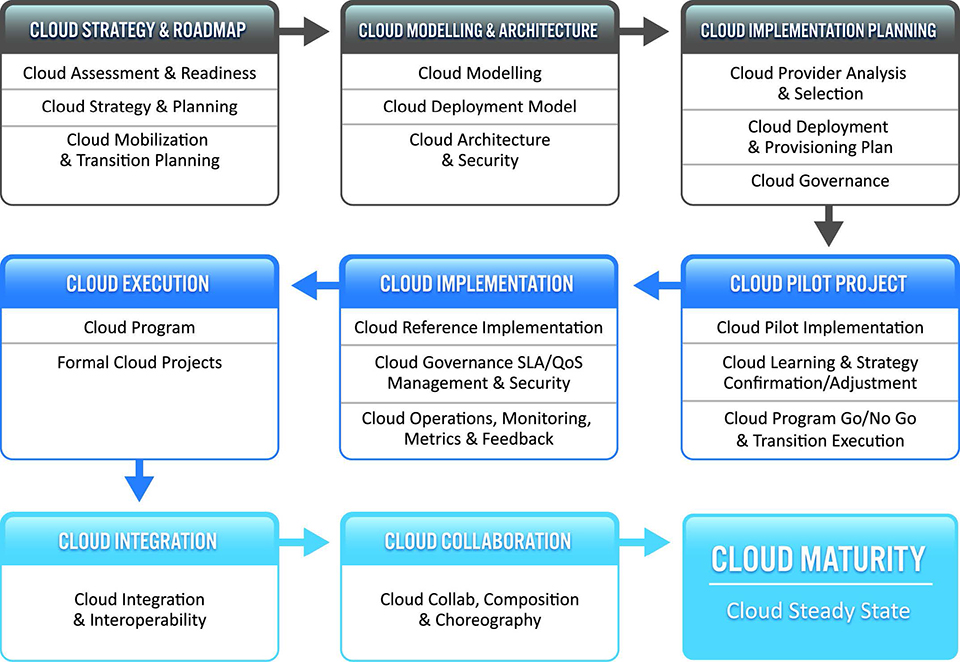IT organizations need to begin thinking and operating more like a service provider.
They should be able to describe their offerings as services based on attributes such as business value, compliance, security, availability and performance. Technology options should be mapped to service offerings and the costs associated with those cloud services. This approach can help to drive more efficient delivery of IT services and increase user satisfaction whether a cloud approach is ultimately pursued or not.
1. Understand that there are many different variants of Cloud services.
The term “Cloud” has become overloaded and now broadly represents a service delivery model that can be applied to a range of services encompassing multiple levels of IT, as well as public and private variants. An important first step is to become educated on the various Cloud options and their nuances. Cloud migrations are implemented in phases or in stages.
2. Approach the Cloud as a tool or another option to provide IT functionality.
Those who have successfully leveraged Cloud technology have done so in a pragmatic or opportunistic fashion. Rather than view the cloud as some sort of computing ideal — “build it and they will come” — think of Cloud offerings as tools or alternative solutions to specific classes of problems.
For example, in the storage arena, an organization may deploy multiple tiers of storage to address different service requirements relating to performance and availability. Cloud storage can be viewed essentially as another option for addressing a set of requirements for one or more tiers. This provides a perspective from which rational decisions can then be made.

3. Identify which elements of your environment may be “Cloud compatible.”
In a given environment, there will likely be some areas that are good candidates to leverage Cloud technologies, while others are “off limits.” Some key factors that might restrict Cloud compatibility include:
Application complexity customized, special-purpose, or legacy applications are the least likely candidates for migration to the Cloud.
Hardware dependencies — again, applications that are not readily deployable on standard platforms or that require special purpose hardware configurations are not likely to be a fit for the Cloud.
Governance and regulatory restrictions requiring controls over where data may be located or comprehensive chain-of-custody monitoring are likely to be excluded from the Cloud.
The goal should be to identify “low-hanging fruit” – application and functional areas that fit a profile and have requirements that align well with the capabilities of a Cloud service.
4. Prepare your organization to “manage” rather than “operate.”
Most IT organizations are technology focused rather than service focused. They are driven by identifying new technologies and identifying opportunities for incorporating them into their environment rather than evaluating current service and efficiency gaps, and then addressing these shortcomings.
The IT organization of tomorrow must be designed to deliver infrastructure “services” aligned with business requirements. In many organizations, this will be accomplished by a combination of delivery methods, including the Cloud. IT should be prepared to manage the entire portfolio, regardless of whether a service is delivered internally or externally. The Cloud, like other outsourcing models, will need to be monitored and evaluated to ensure compliance with stated objectives.
5. Arrange your data to simplify and de-risk your migration.
Adopting a Cloud-based solution will invariably require some amount of migration activity, and proper preparation is essential. Successful migration requires an understanding of your current environment, including identifying application and data dependencies. This is typically done through discovery and analysis.
Aligning data begins by identifying application services, delineating their various sub-components, and then enumerating each instance of the service. From this, it is then possible to effectively plan and sequence the actual migration to the target Cloud environment.
6. Understand your current costs to better quantify the benefit of Cloud services.
The primary attraction of the Cloud, at least initially, is as a more cost-effective means of delivering needed IT functions. Unfortunately, many begin their exploration of Cloud options without accurately understanding their current cost structure. While a Cloud solution provider can clearly state service costs on a per-use basis, internal IT personnel struggle to identify their current costs, making it difficult or impossible to accurately compare or evaluate the differences.















Leave a Reply
Want to join the discussion?Feel free to contribute!